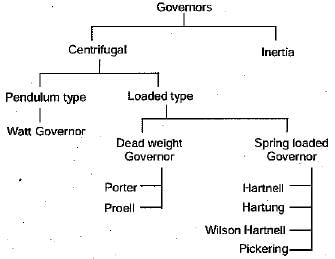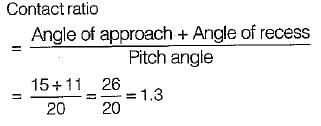All Exams >
Mechanical Engineering >
Topicwise Question Bank for Mechanical Engineering >
All Questions
All questions of Theory of Machines (TOM) for Mechanical Engineering Exam
The velocity of the piston of reciprocating engine is equal to ...where,
ω = angular of crank,
θ = angle turned by crank from IDC,
r - radius of crank,
n = ratio of length of connecting rod to crank radius- a)

- b)

- c)

- d)

Correct answer is option 'C'. Can you explain this answer?
The velocity of the piston of reciprocating engine is equal to ...
where,
ω = angular of crank,
θ = angle turned by crank from IDC,
r - radius of crank,
n = ratio of length of connecting rod to crank radius
ω = angular of crank,
θ = angle turned by crank from IDC,
r - radius of crank,
n = ratio of length of connecting rod to crank radius
a)

b)

c)

d)

|
|
Yash Patel answered |
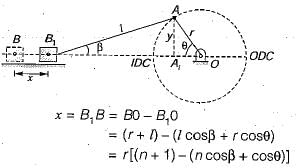
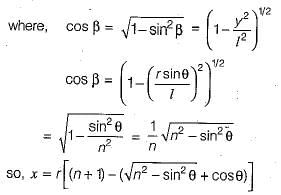

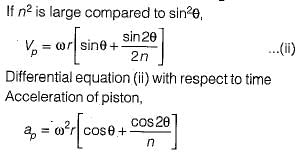
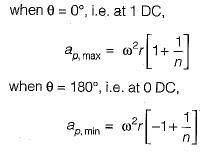
At θ = 180°, when the direction of motion is reversed,
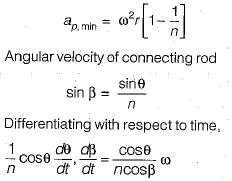

A slider crank mechanism is shown in the given figure.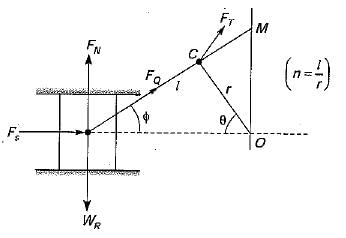 Which of the following expressions stand for crank effort?1.
Which of the following expressions stand for crank effort?1.  2.
2.  3. Fs . OM4. FT.rSelect the correct answer using the codes given below
3. Fs . OM4. FT.rSelect the correct answer using the codes given below- a)1 and 3
- b)1,2 and 4
- c)1, 2 and 3
- d)2, 3 and 4
Correct answer is option 'A'. Can you explain this answer?
A slider crank mechanism is shown in the given figure.

Which of the following expressions stand for crank effort?
1. 

2. 

3. Fs . OM
4. FT.r
Select the correct answer using the codes given below
a)
1 and 3
b)
1,2 and 4
c)
1, 2 and 3
d)
2, 3 and 4
|
|
Sanvi Kapoor answered |
Crank effort: Force is exerted on the crank pin as a result of the force on the piston. Crank effort is the net effort (force) applied at the crank pin perpendicular to the crank which gives the required turning moment on the crank shaft

Which statement is not true about shafts joined by Hook’s joint?- a)the shafts rotate in opposite directions
- b)the shafts may rotate at different angular speeds
- c)the axis of the two shafts coincide
- d)the angle between the axis of the two shafts can be altered whilst the shafts are in motion
Correct answer is option 'C'. Can you explain this answer?
Which statement is not true about shafts joined by Hook’s joint?
a)
the shafts rotate in opposite directions
b)
the shafts may rotate at different angular speeds
c)
the axis of the two shafts coincide
d)
the angle between the axis of the two shafts can be altered whilst the shafts are in motion
|
|
Sanvi Kapoor answered |
The axis of the two shafts is non-parallel and intersecting.
Whirling speed of a shaft coincides with the natural frequency of its- a)longitudinal vibration
- b)transverse vibration
- c)torsional vibration
- d)coupled bending torsional vibration
Correct answer is option 'B'. Can you explain this answer?
Whirling speed of a shaft coincides with the natural frequency of its
a)
longitudinal vibration
b)
transverse vibration
c)
torsional vibration
d)
coupled bending torsional vibration
|
|
Devansh Sengupta answered |
Whirling of shaft occurs when the natural frequency of transverse vibration matches with the frequency of rotating shaft.
Which of the following is an inversion of doubleslider-crank chain?- a)Whitworth quick return mechanism
- b)Reciprocating compressor
- c)Scotch yoke
- d)Rotary engine
Correct answer is option 'C'. Can you explain this answer?
Which of the following is an inversion of doubleslider-crank chain?
a)
Whitworth quick return mechanism
b)
Reciprocating compressor
c)
Scotch yoke
d)
Rotary engine
|
|
Lavanya Menon answered |
Except scotch yoke, all three are inversion of single slider chain.
The safe rim velocity of a flywheel is influenced by the- a)centrifugal stresses
- b)fluctuation of energy
- c)fluctuation of speed
- d)mass of the flywheel
Correct answer is option 'A'. Can you explain this answer?
The safe rim velocity of a flywheel is influenced by the
a)
centrifugal stresses
b)
fluctuation of energy
c)
fluctuation of speed
d)
mass of the flywheel
|
|
Avinash Sharma answered |
Rim velocity 
where
σ = centrifugal stress of circumferential stress
ρ = density of rim materia!
Hence, rim velocity is the function of centrifugal stress and density of rim material.

where
σ = centrifugal stress of circumferential stress
ρ = density of rim materia!
Hence, rim velocity is the function of centrifugal stress and density of rim material.
Which of these mechanisms gives an approximately straight line?- a)Hart
- b)Watt
- c)Paucellier
- d)Kempe
Correct answer is option 'B'. Can you explain this answer?
Which of these mechanisms gives an approximately straight line?
a)
Hart
b)
Watt
c)
Paucellier
d)
Kempe
|
|
Yash Patel answered |
Grass-hoper and watt mechanisms gives an approximately straight line.
In a radial cam, the follower moves in a direction- a)parallel to the cam axis
- b)perpendicular to the cam axis
- c)along the cam axis
- d)perpendicular to the cam profile
Correct answer is option 'B'. Can you explain this answer?
In a radial cam, the follower moves in a direction
a)
parallel to the cam axis
b)
perpendicular to the cam axis
c)
along the cam axis
d)
perpendicular to the cam profile

|
Anirudh Kulkarni answered |
Follower reciprocates in a direction perpendicular to the cam axis in radial cam while follower reciprocates in a direction parallel to-the cam axis.
The space centrode of a circular disc rolling on a straight path is- a)a circle
- b)a parabola
- c)a straight line
- d)ellipse
Correct answer is option 'C'. Can you explain this answer?
The space centrode of a circular disc rolling on a straight path is
a)
a circle
b)
a parabola
c)
a straight line
d)
ellipse
|
|
Arnav Menon answered |
Explanation:
The space centrode of a circular disc rolling on a straight path is a straight line.
Definition of Space Centrode:
The space centrode is the locus of the instantaneous centers of rotation of a rolling body. It is a curve that describes the path traced by the point of contact of two bodies in rolling contact. For a disc rolling on a straight path, the space centrode is a straight line.
Derivation:
Consider a circular disc of radius r rolling on a straight path. Let O be the center of the disc, and P be the point of contact between the disc and the path. Let C be the instantaneous center of rotation of the disc, and let Q be the point of contact between the disc and its image in a plane perpendicular to the path.
Now, as the disc rolls, the point P moves along the path, and the point Q moves along a circle of radius r centered at C. Therefore, the locus of C is a straight line passing through the point of contact P.
Hence, the space centrode of a circular disc rolling on a straight path is a straight line.
Applications:
The concept of space centrode is widely used in kinematics and dynamics of machinery. It is used to analyze the motion of rolling bodies, such as gears, cams, and rollers. The knowledge of space centrode helps in designing mechanisms with desired motion characteristics, such as constant velocity, acceleration, and deceleration. It also helps in minimizing wear and tear of the contacting surfaces, by ensuring that the instantaneous centers of rotation lie on the surfaces.
The space centrode of a circular disc rolling on a straight path is a straight line.
Definition of Space Centrode:
The space centrode is the locus of the instantaneous centers of rotation of a rolling body. It is a curve that describes the path traced by the point of contact of two bodies in rolling contact. For a disc rolling on a straight path, the space centrode is a straight line.
Derivation:
Consider a circular disc of radius r rolling on a straight path. Let O be the center of the disc, and P be the point of contact between the disc and the path. Let C be the instantaneous center of rotation of the disc, and let Q be the point of contact between the disc and its image in a plane perpendicular to the path.
Now, as the disc rolls, the point P moves along the path, and the point Q moves along a circle of radius r centered at C. Therefore, the locus of C is a straight line passing through the point of contact P.
Hence, the space centrode of a circular disc rolling on a straight path is a straight line.
Applications:
The concept of space centrode is widely used in kinematics and dynamics of machinery. It is used to analyze the motion of rolling bodies, such as gears, cams, and rollers. The knowledge of space centrode helps in designing mechanisms with desired motion characteristics, such as constant velocity, acceleration, and deceleration. It also helps in minimizing wear and tear of the contacting surfaces, by ensuring that the instantaneous centers of rotation lie on the surfaces.
At a particular rotational speed, the unbalanced force due to revolving mass- a)varies both in magnitude and direction
- b)is constant in magnitude as well as direction
- c)varies in magnitude but is constant in direction
- d)is constant in magnitude but varies in direction
Correct answer is option 'D'. Can you explain this answer?
At a particular rotational speed, the unbalanced force due to revolving mass
a)
varies both in magnitude and direction
b)
is constant in magnitude as well as direction
c)
varies in magnitude but is constant in direction
d)
is constant in magnitude but varies in direction
|
|
Sanvi Kapoor answered |
Magnitude = mω2r .
It direction is perpendicular to the perphering of rotational envelope in the same plane which changes at every angle.
It direction is perpendicular to the perphering of rotational envelope in the same plane which changes at every angle.
A porter governor has a maximum and minimum speeds of 250 rpm and 200 rpm respectively. If the effective load on the sleeve is 400 N, the governor effort would be- a)18.7 N
- b)100 N
- c)57.8 N
- d)97 N
Correct answer is option 'B'. Can you explain this answer?
A porter governor has a maximum and minimum speeds of 250 rpm and 200 rpm respectively. If the effective load on the sleeve is 400 N, the governor effort would be
a)
18.7 N
b)
100 N
c)
57.8 N
d)
97 N
|
|
Ayush Chawla answered |
The effort of governor is the mean force exerted at the sleeve for a given percentage change in speed




All of the following statements are correct, except,- a)the interval of time taken by a vibrating body to complete a cycle is called period.
- b)the natural frequency of a spring-mass system increases if it is made to operate at a very high altitude.
- c)in the normal or principal mode of vibration all the moving parts of the system oscillate in phase with the same frequency.
- d)the phenomenon of resonance manifests when the frequency of external exciting force coincides with the natural frequency of the system.
Correct answer is option 'B'. Can you explain this answer?
All of the following statements are correct, except,
a)
the interval of time taken by a vibrating body to complete a cycle is called period.
b)
the natural frequency of a spring-mass system increases if it is made to operate at a very high altitude.
c)
in the normal or principal mode of vibration all the moving parts of the system oscillate in phase with the same frequency.
d)
the phenomenon of resonance manifests when the frequency of external exciting force coincides with the natural frequency of the system.
|
|
Isha Nambiar answered |
Mass does not depend on altitude, so natural frequency remains unaffected.
Identity the wrong statement:- a)Turning-moment-diagram is graphical representation of turning moment or crank effort for various positions of the crank.
- b)The area of turning -moment-diagram represents the work done.
- c)The variation of energy above and below the mean resisting torque line is called fluctuation of energy.
- d)The coefficient of fluctuation of energy is defined as the ratio of work done per cycle to the maximum fluctuation of energy.
Correct answer is option 'D'. Can you explain this answer?
Identity the wrong statement:
a)
Turning-moment-diagram is graphical representation of turning moment or crank effort for various positions of the crank.
b)
The area of turning -moment-diagram represents the work done.
c)
The variation of energy above and below the mean resisting torque line is called fluctuation of energy.
d)
The coefficient of fluctuation of energy is defined as the ratio of work done per cycle to the maximum fluctuation of energy.

|
Pranavi Gupta answered |
Explanation:
Incorrect Statement:
The coefficient of fluctuation of energy is defined as the ratio of work done per cycle to the maximum fluctuation of energy.
Explanation:
The coefficient of fluctuation of energy is actually defined as the ratio of the difference between the maximum and minimum energies to the mean energy. It gives an indication of how much energy fluctuates above and below the mean energy level during a cycle.
Correct Definition:
The coefficient of fluctuation of energy is given by the formula:
Coefficient of fluctuation of energy = (Emax - Emin) / Emean
Where:
- Emax is the maximum energy during a cycle
- Emin is the minimum energy during a cycle
- Emean is the mean energy during a cycle
This coefficient helps in analyzing the variation in energy levels and is an important parameter in the study of machine dynamics and performance. It provides insights into the efficiency and smooth operation of machines.
Therefore, the correct definition and calculation of the coefficient of fluctuation of energy are crucial in understanding the energy dynamics of a system and optimizing its performance.
Incorrect Statement:
The coefficient of fluctuation of energy is defined as the ratio of work done per cycle to the maximum fluctuation of energy.
Explanation:
The coefficient of fluctuation of energy is actually defined as the ratio of the difference between the maximum and minimum energies to the mean energy. It gives an indication of how much energy fluctuates above and below the mean energy level during a cycle.
Correct Definition:
The coefficient of fluctuation of energy is given by the formula:
Coefficient of fluctuation of energy = (Emax - Emin) / Emean
Where:
- Emax is the maximum energy during a cycle
- Emin is the minimum energy during a cycle
- Emean is the mean energy during a cycle
This coefficient helps in analyzing the variation in energy levels and is an important parameter in the study of machine dynamics and performance. It provides insights into the efficiency and smooth operation of machines.
Therefore, the correct definition and calculation of the coefficient of fluctuation of energy are crucial in understanding the energy dynamics of a system and optimizing its performance.
Consider a mass m attached at radius r from the axis of shaft which rotates with an angular velocity ω. The balancing is achieved by mounting a B kg mass at radius bfrom the axis of shaft. If the speed of shaft is doubled, then to attain perfect balance, the value of mass B should be- a)halved
- b)doubled
- c)quadrupled
- d)remain unchanged
Correct answer is option 'D'. Can you explain this answer?
Consider a mass m attached at radius r from the axis of shaft which rotates with an angular velocity ω. The balancing is achieved by mounting a B kg mass at radius bfrom the axis of shaft. If the speed of shaft is doubled, then to attain perfect balance, the value of mass B should be
a)
halved
b)
doubled
c)
quadrupled
d)
remain unchanged

|
Sai Sarkar answered |

∴ The value of balancing mass does not depend upon speed of rotation.
In a Kinematic chain, a quarternary joint is equivalent to- a)One binary joint
- b)Two binary joint
- c)Three binary joint
- d)Four binary joint
Correct answer is option 'C'. Can you explain this answer?
In a Kinematic chain, a quarternary joint is equivalent to
a)
One binary joint
b)
Two binary joint
c)
Three binary joint
d)
Four binary joint

|
Divya Mehta answered |
1 quarternary joint is equivalent to three primary joint and 1 turnery joint is equal to 2 binary joint.
The cam follower used in aircraft engies is a- a)roller follower
- b)flat faced follower
- c)spherical faced follower
- d)knife edged follower
Correct answer is option 'A'. Can you explain this answer?
The cam follower used in aircraft engies is a
a)
roller follower
b)
flat faced follower
c)
spherical faced follower
d)
knife edged follower

|
Anisha Chakraborty answered |
Automobile engines generally used spherical faced follower, whereas roller followers are used in aircraft engines. Surface stresses are minimum in mushroom follower with spherical face.
In an epicyclic gear train with a sun gear, planet gear and a moving arm. The ratio of number of teeth of the sun gear to that of the planet gear is 3. If the planet gear is fixed and the arm has an angular velocity of 150 RPM the sun gear will rotate with- a)50 RPM
- b)100 RPM
- c)150 RPM
- d)200 RPM
Correct answer is option 'D'. Can you explain this answer?
In an epicyclic gear train with a sun gear, planet gear and a moving arm. The ratio of number of teeth of the sun gear to that of the planet gear is 3. If the planet gear is fixed and the arm has an angular velocity of 150 RPM the sun gear will rotate with
a)
50 RPM
b)
100 RPM
c)
150 RPM
d)
200 RPM

|
Sahil Mehra answered |
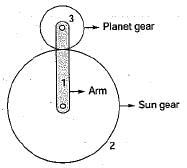

If

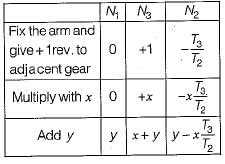
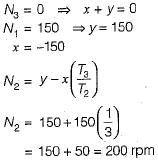
Toggle mechanisms have following applications except- a)stone crushers
- b)gear cutting
- c)embossing presses
- d)switches
Correct answer is option 'B'. Can you explain this answer?
Toggle mechanisms have following applications except
a)
stone crushers
b)
gear cutting
c)
embossing presses
d)
switches
|
|
Sparsh Chakraborty answered |
The mechanisms used to overcome a large resistance of a member with a small driving force are known as snap action or toggle mechanisms. They find their use in a variety of machines such as stone crushers, embossing presses, switches etc.
Select the WRONG statement:- a)vibrations in machines may be due to loose fittings and lack of balance
- b)free vibrations have external force applied at the ends only
- c)forced vibrations are independent of natural frequency of vibration
- d)a vibrating system is said to be stable if the amplitude of vibration decrease With time
Correct answer is option 'B'. Can you explain this answer?
Select the WRONG statement:
a)
vibrations in machines may be due to loose fittings and lack of balance
b)
free vibrations have external force applied at the ends only
c)
forced vibrations are independent of natural frequency of vibration
d)
a vibrating system is said to be stable if the amplitude of vibration decrease With time

|
Aaditya Jain answered |
In free or natural vibrations, no force acts on the body after an initial displacement has been imparted to it.
A flexible rotor-shaft system comprises of a 10 kg rotor disc placed in the middle of a massless shaft of diameter 30 mm and length 500 mm between bearings (shaft is being taken massless as the equivalent mass of the shaft is included in the rotor mass) mounted at the ends. The shaft is made of steel for which the value of E is 2.1 x 1011 Pa. What is the critical speed of rotation of the shaft.- a)60 Hz
- b)90 Hz
- c)135 Hz
- d)180 Hz
Correct answer is option 'B'. Can you explain this answer?
A flexible rotor-shaft system comprises of a 10 kg rotor disc placed in the middle of a massless shaft of diameter 30 mm and length 500 mm between bearings (shaft is being taken massless as the equivalent mass of the shaft is included in the rotor mass) mounted at the ends. The shaft is made of steel for which the value of E is 2.1 x 1011 Pa. What is the critical speed of rotation of the shaft.
a)
60 Hz
b)
90 Hz
c)
135 Hz
d)
180 Hz
|
|
Atharva Majumdar answered |
For shaft loaded at middle with mass M
Deflection
Moment of inertia

So deflection of shaft
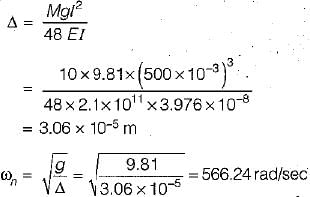
Deflection

Moment of inertia

So deflection of shaft

The rate of decay of oscillations is known as- a)Critical damping
- b)Damping factor
- c)Logarithmic decrement
- d)Damping coefficient
Correct answer is option 'C'. Can you explain this answer?
The rate of decay of oscillations is known as
a)
Critical damping
b)
Damping factor
c)
Logarithmic decrement
d)
Damping coefficient
|
|
Divya Banerjee answered |
Natural logarithm of the amplitude reduction factor is known as logarithmic decrement.
The transmission angle is minimum and maximum respectively, when the crank angle with the fixed link is- a)00 and 2700
- b)900 and 2700
- c)00 and 1800
- d)00 and 900
Correct answer is option 'C'. Can you explain this answer?
The transmission angle is minimum and maximum respectively, when the crank angle with the fixed link is
a)
00 and 2700
b)
900 and 2700
c)
00 and 1800
d)
00 and 900

|
Rohan Singh answered |
Explanation:
The transmission angle is defined as the angle between the coupler link and the output link. It is an important parameter that determines the smoothness of motion in a four-bar linkage mechanism. The optimal transmission angle is 0°, which means that the coupler and output links are aligned. However, in practice, it is not always possible to achieve this ideal condition. Therefore, the transmission angle is usually designed to be as close to 0° as possible.
The transmission angle varies with the crank angle, which is the angle between the fixed link and the crank link. The crank angle determines the position of the mechanism, and it changes as the mechanism moves. The transmission angle is minimum or maximum at specific crank angles, which depend on the geometry of the mechanism.
The transmission angle is minimum when the coupler and output links are parallel, which means that they have the same slope. This occurs when the crank angle is 0° or 180°, which corresponds to the top and bottom dead center positions of the mechanism. At these positions, the coupler link is perpendicular to the fixed link, and the output link is parallel to the fixed link. Therefore, the transmission angle is minimum at crank angles of 0° and 180°.
The transmission angle is maximum when the coupler and output links are perpendicular, which means that they have opposite slopes. This occurs when the crank angle is 90° or 270°, which corresponds to the mid-stroke positions of the mechanism. At these positions, the coupler link is parallel to the fixed link, and the output link is perpendicular to the fixed link. Therefore, the transmission angle is maximum at crank angles of 90° and 270°.
Therefore, the correct answer is option C, which states that the transmission angle is minimum and maximum at crank angles of 0° and 180°, and 90° and 270°, respectively.
The transmission angle is defined as the angle between the coupler link and the output link. It is an important parameter that determines the smoothness of motion in a four-bar linkage mechanism. The optimal transmission angle is 0°, which means that the coupler and output links are aligned. However, in practice, it is not always possible to achieve this ideal condition. Therefore, the transmission angle is usually designed to be as close to 0° as possible.
The transmission angle varies with the crank angle, which is the angle between the fixed link and the crank link. The crank angle determines the position of the mechanism, and it changes as the mechanism moves. The transmission angle is minimum or maximum at specific crank angles, which depend on the geometry of the mechanism.
The transmission angle is minimum when the coupler and output links are parallel, which means that they have the same slope. This occurs when the crank angle is 0° or 180°, which corresponds to the top and bottom dead center positions of the mechanism. At these positions, the coupler link is perpendicular to the fixed link, and the output link is parallel to the fixed link. Therefore, the transmission angle is minimum at crank angles of 0° and 180°.
The transmission angle is maximum when the coupler and output links are perpendicular, which means that they have opposite slopes. This occurs when the crank angle is 90° or 270°, which corresponds to the mid-stroke positions of the mechanism. At these positions, the coupler link is parallel to the fixed link, and the output link is perpendicular to the fixed link. Therefore, the transmission angle is maximum at crank angles of 90° and 270°.
Therefore, the correct answer is option C, which states that the transmission angle is minimum and maximum at crank angles of 0° and 180°, and 90° and 270°, respectively.
In automobiles, Hook's joint is used between which of the following- a)Clutch and gear box
- b)Gear box and differential
- c)Differential and wheels
- d)Flywheel and clutch
Correct answer is option 'B'. Can you explain this answer?
In automobiles, Hook's joint is used between which of the following
a)
Clutch and gear box
b)
Gear box and differential
c)
Differential and wheels
d)
Flywheel and clutch
|
|
Mansi Kulkarni answered |
In automobile Hook’s joint is used between gear box and differential. It is provided on propeller shaft.
The problem of hunting of a centrifugal governor becomes very acute when the governor becomes- a)less sensitive
- b)highly sensitive
- c)high stable
- d)less stable
Correct answer is option 'B'. Can you explain this answer?
The problem of hunting of a centrifugal governor becomes very acute when the governor becomes
a)
less sensitive
b)
highly sensitive
c)
high stable
d)
less stable
|
|
Janhavi Choudhary answered |
Sensitiveness of a governor is a desirable quality. However, if a governor is too sensitive, it may fluctuate continuously above and below the mean position, it is called hunting of governor.
In a Wilson-Hartnell governor, the balls are connected by- a)one spring
- b)two springs in series
- c)two parallel springs
- d)four springs
Correct answer is option 'C'. Can you explain this answer?
In a Wilson-Hartnell governor, the balls are connected by
a)
one spring
b)
two springs in series
c)
two parallel springs
d)
four springs

|
Maulik Joshi answered |
Wilson-Harnell governor (also known as radial spring controller) uses two parallel springs alongwith an auxiliary spring.
Cam and follower mechanism constitutes a kinematic pair of the type- a)lower and open
- b)higher and open
- c)lower and closed
- d)higher and closed
Correct answer is option 'B'. Can you explain this answer?
Cam and follower mechanism constitutes a kinematic pair of the type
a)
lower and open
b)
higher and open
c)
lower and closed
d)
higher and closed
|
|
Gaurav Kapoor answered |
Cam and follower have line or point contact, so it is higher pair. It is closed when retainer spring is used, usually it is of open type.
Oldham’s coupling is used to connect two shafts which are- a)intersecting
- b)parallel
- c)perpendicular
- d)co-axial
Correct answer is option 'B'. Can you explain this answer?
Oldham’s coupling is used to connect two shafts which are
a)
intersecting
b)
parallel
c)
perpendicular
d)
co-axial
|
|
Anjali Shah answered |
Two shafts are parallel with offset.
The mechanism used to overcome a large resistance of a member with a small driving force is known as- a)Indexing mechanism
- b)Snap action mechanism
- c)Whitworth mechanism
- d)Crank rocker mechanism
Correct answer is option 'B'. Can you explain this answer?
The mechanism used to overcome a large resistance of a member with a small driving force is known as
a)
Indexing mechanism
b)
Snap action mechanism
c)
Whitworth mechanism
d)
Crank rocker mechanism
|
|
Sarita Yadav answered |
The mechanisms used to overcome a large resistance of a member with a small driving force are known as snap action or toggle mechanisms.
Klein’s construction is a graphical method of determining- a)acceleration of various parts
- b)velocity of various parts
- c)displacement of various parts
- d)forces acting on various parts
Correct answer is option 'A'. Can you explain this answer?
Klein’s construction is a graphical method of determining
a)
acceleration of various parts
b)
velocity of various parts
c)
displacement of various parts
d)
forces acting on various parts
|
|
Pankaj Joshi answered |
Klein’s construction for reciprocating engine mechanism:
(i) has a simpler construction for getting quadrilateral similar to the diagram of mechanism for reciprocating engine.
(ii) is applicable when the crank has uniform angular velocity.
(iii) is used to determine the linear velocity and acceleration of piston.
(i) has a simpler construction for getting quadrilateral similar to the diagram of mechanism for reciprocating engine.
(ii) is applicable when the crank has uniform angular velocity.
(iii) is used to determine the linear velocity and acceleration of piston.
In a four-bar linkage, the sum of the lengths of the smallest and the longest link is less than the sum of the lengths of the other two links. If the smallest link is fixed, the linkage becomes a- a)structure
- b)double-rocker
- c)double crank mechanism
- d)crank-rocker mechanism
Correct answer is option 'C'. Can you explain this answer?
In a four-bar linkage, the sum of the lengths of the smallest and the longest link is less than the sum of the lengths of the other two links. If the smallest link is fixed, the linkage becomes a
a)
structure
b)
double-rocker
c)
double crank mechanism
d)
crank-rocker mechanism

|
Diya Sarkar answered |
For a four bar mechanism If S + L ≤ Sum of other two and if smallest link is fixed then crank-crank mechanism can be obtained.
Two parallel shafts whose axes are separated by a distance of 75 mm are to be connected a spur gear set so that the output shaft rotates at 50% of the speed of the input shaft which of the following could be the possible pitch circle diameters of the gears.- a)25 mm and 50 mm
- b)30 mm and 60 mm
- c)50 mm and 100 mm
- d)60 mm and 120 mm
Correct answer is option 'C'. Can you explain this answer?
Two parallel shafts whose axes are separated by a distance of 75 mm are to be connected a spur gear set so that the output shaft rotates at 50% of the speed of the input shaft which of the following could be the possible pitch circle diameters of the gears.
a)
25 mm and 50 mm
b)
30 mm and 60 mm
c)
50 mm and 100 mm
d)
60 mm and 120 mm
|
|
Niharika Iyer answered |
Centre distance between the shaft = 75 mm
Hence

Also,

Hence

Also,

In a simple gear train, if the number of idle gears is odd, then the motion of driven gear will - a)be opposite as that of driving gear
- b)be same as that of driving gear
- c)depend upon the number of teeth on the driving gear
- d)none of the mentioned
Correct answer is option 'B'. Can you explain this answer?
In a simple gear train, if the number of idle gears is odd, then the motion of driven gear will
a)
be opposite as that of driving gear
b)
be same as that of driving gear
c)
depend upon the number of teeth on the driving gear
d)
none of the mentioned
|
|
Sanvi Kapoor answered |
The speed ratio and the train value, in a simple train of gears, is independent of the size and number of intermediate gears. These intermediate gears are called idle gears, as they do not affect the speed ratio or train value of the system.
The term “effort of governor” refers to- a)mean force acting on sleeve for given change in speed
- b)work done on the sleeve for given change in speed
- c)useful power developed
- d)equivalent centrifugal force
Correct answer is option 'A'. Can you explain this answer?
The term “effort of governor” refers to
a)
mean force acting on sleeve for given change in speed
b)
work done on the sleeve for given change in speed
c)
useful power developed
d)
equivalent centrifugal force
|
|
Nandita Chakraborty answered |
The effort of a governor is the mean force exerted at the sleeve for a given percentage change of speed.
The Grubler’s criteria for planar mechanism is given by f = 3(n-1) - 2j
j in the equation is- a)number of mobile links
- b)number of links
- c)number of lower pairs
- d)length of longest link
Correct answer is option 'C'. Can you explain this answer?
The Grubler’s criteria for planar mechanism is given by f = 3(n-1) - 2j
j in the equation is
j in the equation is
a)
number of mobile links
b)
number of links
c)
number of lower pairs
d)
length of longest link
|
|
Nandini Basak answered |
In the equation
f = 3(n -1) - 2j
n = Number of links
j = Number of lower pair
f = 3(n -1) - 2j
n = Number of links
j = Number of lower pair
Match List - I (Terms) with List - II (Definitions) and select the correct answer using the codes given below the lists:
List-I
A. Module
B. Addendum
C. Circular pitch
List-II
1. Radial distance of a tooth from the pitch circle to the top of the tooth
2. Radial distance of a tooth from the pitch circle to the bottom of the tooth
3. Distance on the circumference of the pitch circle from a point of one tooth to the corresponding point on the next tooth
4. Ratio of pitch circle diameter in mm to the number of teeth
Codes:
A B C
(a) 4 1 3
(b) 4 2 3
(c) 3 1 2
(d) 3 2 4- a)(a)
- b)(b)
- c)(c)
- d)(d)
Correct answer is option 'A'. Can you explain this answer?
Match List - I (Terms) with List - II (Definitions) and select the correct answer using the codes given below the lists:
List-I
A. Module
B. Addendum
C. Circular pitch
List-II
1. Radial distance of a tooth from the pitch circle to the top of the tooth
2. Radial distance of a tooth from the pitch circle to the bottom of the tooth
3. Distance on the circumference of the pitch circle from a point of one tooth to the corresponding point on the next tooth
4. Ratio of pitch circle diameter in mm to the number of teeth
Codes:
A B C
(a) 4 1 3
(b) 4 2 3
(c) 3 1 2
(d) 3 2 4
List-I
A. Module
B. Addendum
C. Circular pitch
List-II
1. Radial distance of a tooth from the pitch circle to the top of the tooth
2. Radial distance of a tooth from the pitch circle to the bottom of the tooth
3. Distance on the circumference of the pitch circle from a point of one tooth to the corresponding point on the next tooth
4. Ratio of pitch circle diameter in mm to the number of teeth
Codes:
A B C
(a) 4 1 3
(b) 4 2 3
(c) 3 1 2
(d) 3 2 4
a)
(a)
b)
(b)
c)
(c)
d)
(d)
|
|
Sharmila Chauhan answered |
Explanation:
Module:
- Module is the ratio of pitch circle diameter in mm to the number of teeth.
- It is represented as M = D/N, where M is the module, D is the pitch circle diameter, and N is the number of teeth.
Addendum:
- Addendum is the radial distance of a tooth from the pitch circle to the top of the tooth.
- It is the height of the tooth above the pitch circle.
Circular pitch:
- Circular pitch is the distance on the circumference of the pitch circle from a point of one tooth to the corresponding point on the next tooth.
- It is the distance between corresponding points on adjacent teeth measured along the pitch circle.
Correct answer:
The correct match for each term is:
- Module: Ratio of pitch circle diameter in mm to the number of teeth (4)
- Addendum: Radial distance of a tooth from the pitch circle to the top of the tooth (1)
- Circular pitch: Distance on the circumference of the pitch circle from a point of one tooth to the corresponding point on the next tooth (3)
Therefore, the correct answer is option (a) 4 1 3.
Module:
- Module is the ratio of pitch circle diameter in mm to the number of teeth.
- It is represented as M = D/N, where M is the module, D is the pitch circle diameter, and N is the number of teeth.
Addendum:
- Addendum is the radial distance of a tooth from the pitch circle to the top of the tooth.
- It is the height of the tooth above the pitch circle.
Circular pitch:
- Circular pitch is the distance on the circumference of the pitch circle from a point of one tooth to the corresponding point on the next tooth.
- It is the distance between corresponding points on adjacent teeth measured along the pitch circle.
Correct answer:
The correct match for each term is:
- Module: Ratio of pitch circle diameter in mm to the number of teeth (4)
- Addendum: Radial distance of a tooth from the pitch circle to the top of the tooth (1)
- Circular pitch: Distance on the circumference of the pitch circle from a point of one tooth to the corresponding point on the next tooth (3)
Therefore, the correct answer is option (a) 4 1 3.
Examine the figure shown below wherein the numbers indicate the links:
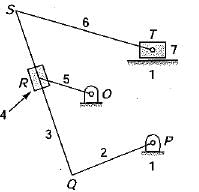 Which of the statements given below are correct?
Which of the statements given below are correct?
1. I34 is at ∞, perpendicular to QS
2. I45 is at perpendicular to QS
3. I71 is at T
4. I45 is at R- a)1 and 2
- b)1 and 4
- c)2 and 3
- d)1, 3 and 4
Correct answer is option 'B'. Can you explain this answer?
Examine the figure shown below wherein the numbers indicate the links:


Which of the statements given below are correct?
1. I34 is at ∞, perpendicular to QS
2. I45 is at perpendicular to QS
3. I71 is at T
4. I45 is at R
1. I34 is at ∞, perpendicular to QS
2. I45 is at perpendicular to QS
3. I71 is at T
4. I45 is at R
a)
1 and 2
b)
1 and 4
c)
2 and 3
d)
1, 3 and 4

|
Anwarali Shaikh answered |
I don't understand why 4th statement is correct.Can anyone explain
The locus of instantaneous center of a moving body relative to a fixed body is known as the- a)space centrode
- b)bodycentrode
- c)moving centrode
- d)none of these
Correct answer is option 'A'. Can you explain this answer?
The locus of instantaneous center of a moving body relative to a fixed body is known as the
a)
space centrode
b)
bodycentrode
c)
moving centrode
d)
none of these

|
Arnab Saini answered |
A centrode is the locus of the I-center of a plane body relative to another plane body for the range of motion specified or during a finite period of time.
Space centrode (or fixed centrode) is the locus of the I-center of the moving body relative to the fixed body.
Body centrode (or moving centrode) is the locus of the I-center of the fixed body relative to the movable body.
Space centrode (or fixed centrode) is the locus of the I-center of the moving body relative to the fixed body.
Body centrode (or moving centrode) is the locus of the I-center of the fixed body relative to the movable body.
Klein’s construction can be used when- a)Crank has a uniform angular velocity
- b)Crank has a non-uniform velocity
- c)Crank has uniform angular acceleration
- d)Crank has a uniform angular velocity and angular acceleration
Correct answer is option 'A'. Can you explain this answer?
Klein’s construction can be used when
a)
Crank has a uniform angular velocity
b)
Crank has a non-uniform velocity
c)
Crank has uniform angular acceleration
d)
Crank has a uniform angular velocity and angular acceleration
|
|
Nitin Joshi answered |
Klein’s construction is used to determine the acceleration of various parts and this method is used when crank has uniform angular velocity.
The number of links in a planer mechanism with revolute joints having 10 instantaneous centre is- a)3
- b)4
- c)5
- d)6
Correct answer is option 'C'. Can you explain this answer?
The number of links in a planer mechanism with revolute joints having 10 instantaneous centre is
a)
3
b)
4
c)
5
d)
6
|
|
Kajal Tiwari answered |
Number of instantaneous centre

for n = 5
we get Number of instantaneous centre = 10

for n = 5
we get Number of instantaneous centre = 10
Effect of friction, at the sleeve of a centrifugal governor is to make it- a)more sensitive
- b)more stable
- c)insensitive over a small range of speed
- d)unstable
Correct answer is option 'C'. Can you explain this answer?
Effect of friction, at the sleeve of a centrifugal governor is to make it
a)
more sensitive
b)
more stable
c)
insensitive over a small range of speed
d)
unstable
|
|
Ameya Kaur answered |
Friction at the sleeve makes the governor less sensitive.
The lead screw of a lathe with nut is a- a)roiling pair
- b)screw pair
- c)turning pair
- d)sliding pair
Correct answer is option 'B'. Can you explain this answer?
The lead screw of a lathe with nut is a
a)
roiling pair
b)
screw pair
c)
turning pair
d)
sliding pair
|
|
Isha Nambiar answered |
If two mating links have a turning as well as sliding motion between them, they form a screw pair. This is achieved by cutting matching threads on the two links. The lead screw and the nut of a lathe is a screw pair.
Chapter doubts & questions for Theory of Machines (TOM) - Topicwise Question Bank for Mechanical Engineering 2025 is part of Mechanical Engineering exam preparation. The chapters have been prepared according to the Mechanical Engineering exam syllabus. The Chapter doubts & questions, notes, tests & MCQs are made for Mechanical Engineering 2025 Exam. Find important definitions, questions, notes, meanings, examples, exercises, MCQs and online tests here.
Chapter doubts & questions of Theory of Machines (TOM) - Topicwise Question Bank for Mechanical Engineering in English & Hindi are available as part of Mechanical Engineering exam.
Download more important topics, notes, lectures and mock test series for Mechanical Engineering Exam by signing up for free.
Topicwise Question Bank for Mechanical Engineering
45 videos|314 tests
|

Contact Support
Our team is online on weekdays between 10 AM - 7 PM
Typical reply within 3 hours
|
Free Exam Preparation
at your Fingertips!
Access Free Study Material - Test Series, Structured Courses, Free Videos & Study Notes and Prepare for Your Exam With Ease

 Join the 10M+ students on EduRev
Join the 10M+ students on EduRev
|

|
Create your account for free
OR
Forgot Password
OR
Signup to see your scores
go up
within 7 days!
within 7 days!
Takes less than 10 seconds to signup





